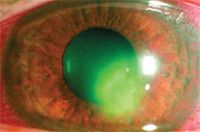Article
MEEI experience characterizes changing epidemiology of fungal keratitis
Las Vegas-A review of fungal keratitis cases seen in a recent 2-year period at the Massachusetts Eye and Ear Infirmary (MEEI) indicates that a change has occurred in the pathogens, risk factors, and treatment options for these infections, said Kathryn A. Colby, MD, PhD, at the annual meeting of the American Academy of Ophthalmology.

She reported that, in a span of 24 months during 2004 to 2006, there was a marked increase in the number of filamentous fungal infections and more cases occurring in soft contact lens wearers when compared with a 47-month period from 1999 through 2002. Although some of the infections in the more recent period were related to use of a multipurpose solution (ReNu with MoistureLoc, Bausch & Lomb), contact lens wearers were still presenting with fungal keratitis even 6 months after that product was pulled from the market, reported Dr. Colby, director, Joint Clinical Research Center, MEEI, Harvard University, Boston.
"The findings in our review suggest other issues are involved and indicate that we are not yet at the end of this disturbing epidemic of fungal keratitis. Until we are able to determine all of the etiologic factors, we urge clinicians to remain vigilant and have a high index of suspicion for fungal keratitis," she said. "In addition, we highly endorse the suggestion by Dr. Elisabeth Cohen in an Archives of Ophthalmology editorial that single-use, daily disposable contact lenses be considered whenever possible," she said. Dr. Colby told attendees that because of the colder climate in New England, fungal keratitis has been relatively rare. Historically, typical cases involved Candida infections in eyes with a compromised ocular surface.
The case of a patient referred in January 2006 to the MEEI for culture-negative keratitis unresponsive to antibiotics alerted Dr. Colby and colleagues to a possible shift in the epidemiology of fungal keratitis and led them to conduct a more formal review to investigate that concept. The referred patient had no history of ocular trauma outdoors, but she wore 2-week disposable soft contact lenses that she cleaned with a multipurpose solution. Corneal biopsies and cultures of the stromal bed grew Fusarium.
Dr. Colby and colleagues previously had analyzed features of fungal keratitis cases seen at MEEI between 1999 and 2002. Their findings showed 23 cases during that period, of which 16 (70%) were caused by Candida and seven (30%) involved filamentous fungi. Over the 24-month period from March 2004 to March 2006, 17 cases of fungal keratitis were seen, of which 15 (88%) were caused by filamentous fungi and only two (12%) were caused by Candida.
"In the earlier period, there were three cases of Fusarium infection, and all had a history of outdoor trauma. During the more recent period, there were eight cases of Fusarium infection," Dr. Colby reported.
Among the 17 patients seen between 2004 and 2006, nine patients (53%) wore soft contact lenses, of whom only three specifically remembered using the recalled multipurpose solution. In contrast, only four (18%) of the fungal keratitis cases seen at MEEI during the earlier series were in soft contact lens wearers.
Of the remaining cases seen between 2004 and 2006, one occurred in a patient with a history of trauma, four affected patients had ocular surface disease, and the remaining three cases were in patients who wore a therapeutic soft contact lens continuously in association with a keratoprosthesis (Boston K-Pro).
Outcomes generally were favorable in the soft contact lens wearers and patient with ocular trauma in the recent series. In addition to topical antifungal treatment, seven of those 10 individuals were treated with oral voriconazole (Vfend, Pfizer). Visual outcome was 20/30 uncorrected visual acuity in the patient with trauma and 20/20 to 20/70 with correction in the contact lens wearers. The patient with a 20/70 outcome was a contact lens wearer who presented with a very advanced ulcer and went on to require penetrating keratoplasty.

Study validates long-term efficacy of MicroPulse TLT for glaucoma management



